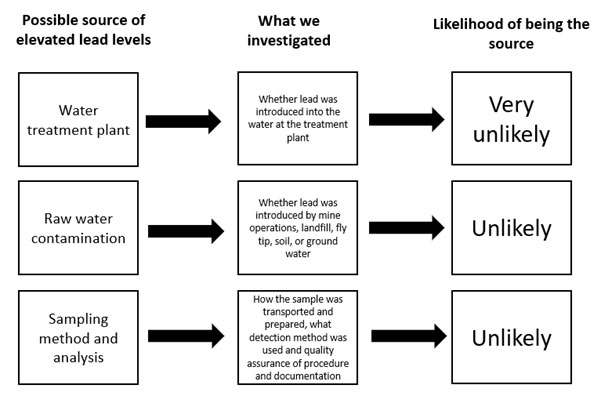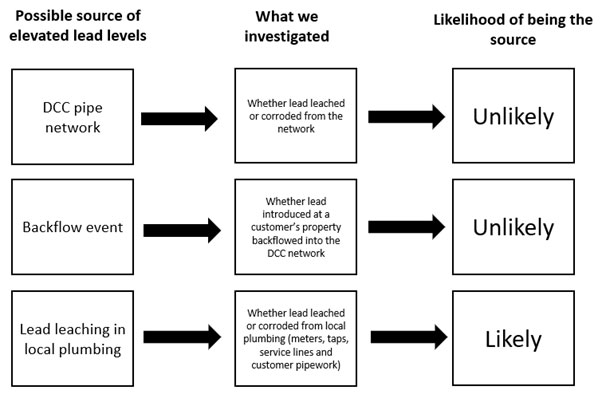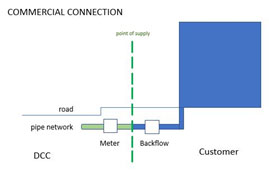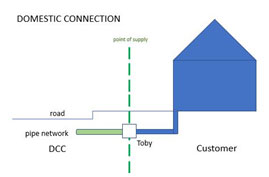-
Investigation
How can we be sure the water is safe to drink?
In conjunction with Public Health South, we can advise the water is safe to drink and use in food preparation from Wednesday, 28 July. Extensive investigations show there is no widespread lead in the DCC’s drinking water network. We’ve done more than 2000 tests throughout the network and results show no instances of elevated lead from the network side. However, on the customer side, there is still a risk of lead leaching into water from metal pipes or fittings so please follow the flushing advice (see below) before drinking the water from your taps.
What was the cause of the elevated lead levels?
Extensive investigation shows the elevated lead levels relate mainly to private pipes and fittings.
Most of the samples collected had no detectable lead. When lead was found in the water, it was only in some parts of the network. It’s been found the most likely cause was lead leaching from pipes and fittings on private properties, not from the Waikouaiti River or the wider DCC drinking water distribution network.
How did you work that out?
Our wide-ranging investigation looked at all possibilities, including whether lead came from old landfills, fly tips or Macraes mine, or from the DCC pipe network.
This table provides a summary of possible sources of lead, what we investigated and what the result was. See our investigation report (PDF, 5.2MB | Opens in new window) for more details.


How do you explain the high raw water reading then?
The raw water result on 20 January 2021 was most likely caused by tiny grains of solid lead particles in sediment stirred up in the river. This sample coincided with the raw water reservoir running at a low level, and a higher probability of sediment disturbance. These particles of lead are removed by the water treatment process. Through our investigation work, we have found that the most likely cause of the high lead readings in the network (including 8 December 2020) is leaching or small particles from private pipes and fittings.
How do you explain the two high readings that happened on the same day at opposite ends of the network? Does that mean there could be something upstream?
Our investigation considered the possibility of whether the spikes at the Karitane Bowling Club and Waikouaiti Golf Club resulted from the same upstream cause. We found no evidence of a source of lead from the river or from the water treatment plant. Also, no other direct link between the two spikes was found. This strongly indicates that the elevated results related to the customer fittings at the individual clubs. See investigation report (PDF, 5.2MB | Opens in new window) for more details.
What about the water supply at the Karitane Bowling Club and Waikouaiti Golf Club where they had the high readings – can we drink the water there now?
It is safe to drink the water at the Karitane Bowling Club. The investigation shows the high lead readings were most likely due to the leaching of lead from a DCC water meter, which has since been replaced.
People should still not drink the water at the Waikouaiti Golf Club. We are working with the club and it is planning to replace water pipes on the property, which should resolve the issue. We have also replaced the DCC water meter and some fittings at the golf club.
Are you still testing the water?
Yes. Since increased testing began on 4 February, there have been no further elevated lead readings in the distribution network. We will continue to do weekly sampling and we have installed new equipment to test water at the Waikouaiti water treatment plant.
We have had some elevated results that relate specifically to tapware. These ‘pre-flush’ results are samples that are taken from water that has been sitting in the taps for some time. A few of these taps are DCC taps and some are privately owned.
Where did you do the water sampling?
Before the ‘do not drink’ notice was issued, all of the sampling sites in the affected communities were on the customer side. That means the water taken for testing was from private pipes, not from DCC pipes. Those sampling sites include the Waikouaiti Golf Club and Karitane Bowling Club. Once the notice was in place, we also installed dedicated sampling taps on DCC pipes so we could test the water we supply to your boundary.
We also do regular water testing at the Waikouaiti river and after the water treatment plant.
What are pre-flush and post-flush samples?
These terms are used when taking the water samples at the various tap locations.
Pre-flush - is the first litre of water that comes out of your tap. This water has typically been in contact with fittings which contain traces of lead.
Post-flush - is once the tap has been running for a few minutes.
Post-flush sampling represents the water that arrives at your boundary from the DCC water supply and is the best indicator of the overall water quality in the network.
Why has it taken so long to find out the cause?
The safety of our communities is our top priority. We needed to investigate all possible causes before lifting the ‘do not drink’ notice and gathered lots of samples to identify if and where lead was present.
It was necessary to investigate all other possibilities to reach this conclusion confidently.
Does this mean there isn’t any lead in the river?
There is lead naturally occurring in the environment at very low levels, including in rock, soil and river sediment. The investigation shows this lead is typically in solid form. There has been no evidence of lead in the raw water supply since the reading on 20 January 2021. If there were any lead particles the processes at the treatment plant would filter them out.
If the problem is with my property’s plumbing, what do I do?
In most cases, all you’ll need to do is flush your taps every day.
The drinking water that comes from our network supply is safe. However, metals such as lead can leach from your pipes and fittings into the water if it’s been sitting for a while, such as overnight.
The Ministry of Health notes that taps are the main source of heavy metals found in drinking water in most houses, and advises flushing a small volume of water – about 500ml – from the cold tap before you use water for drinking, cooking or brushing your teeth. You should also run a cold tap for about 30 seconds each morning, to flush out the water sitting in your pipes overnight.
This flushing should reduce the risk of drinking water containing metals.
This is all that most people need to do, but longer flushing is advised in a few situations, such as if your building has large diameter pipes, is located a long way from the road or has high-risk fittings. (see FAQ below).
If you think this might apply to you, please go to flushing for specific sites page for specific advice.
The need to flush taps daily is a key message for all residents around the country and overseas, not just Waikouaiti, Karitane and Hawksbury Village and the rest of Dunedin.
-
Home And Business
If the problem is with my property’s plumbing, what do I do?
In most cases, all you’ll need to do is flush your taps every day.
The drinking water that comes from our network supply is safe. However, metals such as lead can leach from your pipes and fittings into the water if it’s been sitting for a while, such as overnight.
The Ministry of Health notes that taps are the main source of heavy metals found in drinking water in most houses, and advises flushing a small volume of water – about 500ml – from the cold tap before you use water for drinking, cooking or brushing your teeth. You should also run a cold tap for about 30 seconds each morning, to flush out the water sitting in your pipes overnight.
This flushing should reduce the risk of drinking water containing metals.
This is all that most people need to do, but longer flushing is advised in a few situations, such as if your building has large diameter pipes, is located a long way from the road or has high-risk fittings. (see FAQ below).
If you think this might apply to you, please go to flushing for specific sites page for specific advice.
The need to flush taps daily is a key message for all residents around the country and overseas, not just Waikouaiti, Karitane and Hawksbury Village and the rest of Dunedin.
What are high risk fittings?
These are older fittings such as taps that are made of materials like brass and galvanised iron. Today’s modern fittings still contain some lead. When buying tapware, you should look for products that comply with plumbing standard AS/NZS 4020:2018.
Why didn’t I know about flushing taps before now?
The DCC, like most local authorities, sends a twice yearly reminder to residents to flush their taps, as required by the Ministry of Health. This reminder goes out in the FYI newsletter. We will ensure this message is more widely promoted in the future.
What if I’m still worried?
If you’re still concerned you can get a plumber to check the condition of the water pipes and connections on your property. There is also the option of installing a water filter to remove any lead coming into your home or business supply. If you have any health concerns you should contact your health professional.
Where does the water connection start from for my property?


My house is new/only a few years old – do I still need to flush my taps every day?
Yes. Even new plumbing, such as pipes and fittings, can contain some trace of lead, which can leach into the water if it’s been sitting overnight. Although the risk from heavy metals in drinking water is small, daily flushing is recommended as a precaution. You should also still flush a small volume of water – about 500ml – from the cold tap before you use water for drinking, cooking or brushing your teeth, because your tapware, even though it is new, may leach a small amount of lead.
I’ve checked the water pipes in my house and they are PVC – do I still need to flush my taps every day?
Yes. While the pipes you can see may be plastic, other fittings can contain some trace of lead. There may also be underground metal water pipes that you can’t see. Although the risk from heavy metals in drinking water is small, daily flushing is recommended as a precaution. You should also still flush a small volume of water – about 500ml – from the cold tap before you use water for drinking, cooking or brushing your teeth, because your tapware may leach a small amount of lead.
Does my toby need to be replaced?
No, residents just need to follow the advice to flush their taps daily.
Is this just a local issue?
No. Lead leaching from pipes and fittings into water is a national and international issue.
In its review into the health response to the lead contamination, the Ministry of Health has flagged some issues that need to be picked up nationally. These recommendations include that the Ministry, Taumata Arowai (the new water services regulator) and other relevant parties carry out a review of the current plumbing standards. This review should specifically look at the implications of allowable lead levels in imported tapware and fittings.
Will you still keep water tanks in the affected areas?
We removed the last public water tank at the end of August. The area’s tap water is safe to drink and use in food preparation and cooking, as long as people follow advice about flushing their taps.
What will happen to the tanks that are no longer needed?
Most of the tanks will be removed and put into storage. One tank will be left in the community so it is available in case of a civil defence or other emergency.
I have my own tank – does this need to be tested or cleaned before I start drinking the water again?
No. Based on all the investigation work carried out, the results show the issue is with local plumbing, not with the DCC network. This means widespread lead contamination is very unlikely to have occurred, therefore tanks won’t require cleaning.
You should continue to inspect, clean and maintain your tank as you regularly would.
What do I do with my water container?
You’re welcome to keep the container – it’s a great way to store water as part of the supplies you would need in an emergency. Visit https://getready.govt.nz/prepared/household/supplies/storing-water/ for more information.
Staff are looking at what options there are for containers that are no longer needed. We’ll provide that information soon.
When will you read my commercial water meter again?
The last quarterly invoice (January - March) was estimated at approximately 50% of your regular use. We took actual readings for the next quarter (April - June). The billing will be based on that actual meter reading less the meter reading of the earlier estimate. Invoices were sent in July.
Will we get a refund on a portion of our rates or water charges since we didn’t have drinking water?
The DCC has continued to provide an alternative safe and secure drinking water supply to all residents of Karitane, Waikouaiti and Hawksbury Village, as well as the businesses operating in this area of the network as we investigated the cause.
The average household uses 235 litres of water per person/day. Of this, about two litres are used for drinking. Household water supply has continued throughout.
No compensation will be offered at this stage, however any business who has suffered a loss during this time should contact their insurer.
-
Next Steps
What’s the state of play with the new water monitor?
We are continuing to calibrate this specialist piece of equipment to ensure results are reliable. It’s not a critical part of our testing regime, but it will provide useful extra information.
What is the DCC doing about its pipes and fittings?
While the issue is mainly with private pipes and fittings, we are looking into alternative fittings that contain reduced or no lead to be used in future network replacement programmes. Where possible we will use products that have reduced or no lead as they become available.
When will the Waikouaiti water treatment plant be upgraded?
Planning for the Waikouaiti water treatment plant upgrade has been completed and McConnell Dowell has been appointed as our construction partner. Once we have all necessary consents, construction is due to be carried out and finished in stages, from the end of 2023 to the first half of 2024.
Will the water taste and smell better after that upgrade?
A key aspect of the water treatment plant upgrade is to review options to improve taste and odour of the water. The University of Otago has been assisting with identifying the source of compounds in the river which contribute to the bad taste.
When will you tell us what happened in your internal review?
The independent review into the internal DCC processes will begin once the ‘do not drink’ notice is lifted. The outcome of the review will be publicly reported back to the Council and community once complete.
What will the review cover?
The review will look at the DCC’s response to the discovery of lead in the drinking water of Waikouaiti, Karitane and Hawksbury Village. You can find the full terms of reference here. (PDF,39.1kb | Opens in new window)
-
E. coli information
How do you know there is no longer E. coli in the water?
We’ve done extensive investigation, looking at how this result might have happened.
In the 12 days following E. coli being found we took 48 samples from four locations in Waikouaiti and Karitane. No E. coli was detected in any of these and no sources of contamination in the water distribution system have been identified.
The water treatment plant at Waikouaiti has processes to remove bacteria such as E. coli, including filtration and disinfection. The treatment plant was found to be operating normally and we are confident there is no E. coli in the water.
Will you continue testing for E. coli?
The DCC regularly tests for E. coli as required by the New Zealand Drinking Water Standards. This includes weekly testing in the Waikouaiti, Karitane and Hawksbury village scheme.
We also monitor treatment processes at the water treatment plant to ensure the water is safe.
Does this mean there was faecal material in the water?
E. coli are common bacteria normally found in the gut of warm-blooded animals and people.
The presence of E. coli is typically an indicator that water may be contaminated with faecal material, but this is not thought to be the case in this instance.
The most likely cause in this case is contamination of the sample rather than the water itself.
What caused this result?
A number of potential causes were investigated, including treatment plant malfunction and contamination of water caused by things like broken pipes.
The most likely cause in this case is contamination of the sample rather than the water itself.
Our laboratory goes through rigorous IANZ accreditation and works under strict protocols to ensure sampling is representative and reliable. However, this type of sampling is very sensitive to environmental contamination because microorganisms such as bacteria are all around us.
Is it unusual for E. coli to be in drinking water?
Yes, it is unusual. Over the past two years, there have been more than 2,300 E. coli tests across Dunedin’s water supplies. Only two had detectable levels of E. coli and in both cases no E. coli was found in follow up testing.
Why do you test for this?
We monitor for E. coli to determine whether the water supply meets the New Zealand Drinking Water Standards.
What level of E coli is safe?
There are many types of E. coli, most are harmless but some can cause illness.
E coli. is typically an indicator of faecal contamination which could mean other pathogens are present, so no level of E. coli is acceptable in drinking water.
How can I be sure this won’t happen again?
It is unusual for E. coli to be found in the water supply. We’ll continue regular testing and have procedures in place should any be detected in the future.
The water treatment plant at Waikouaiti has processes to remove E. coli, including filtration and disinfection.
What about the coliform reading?
Four total coliform tests detected some bacteria. It isn’t unusual to find coliforms in water, but this doesn’t mean it’s not safe to drink. Elevated levels of coliforms are generally not of concern, unless coupled with an E. coli result or another issue with the water supply. Many types of coliforms are harmless.
Current Alerts and Notices (View all)
FAQs – ‘do not drink’ notice lifted
Last updated: 26 Jul 2024 3:08pm
